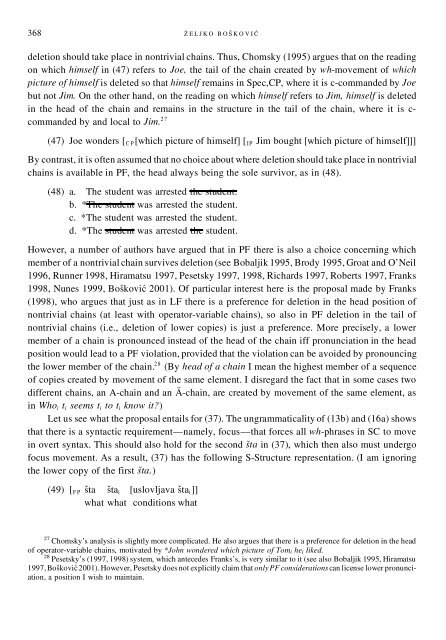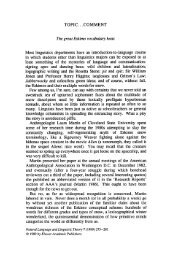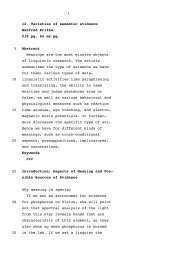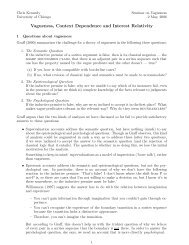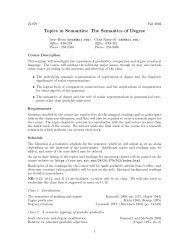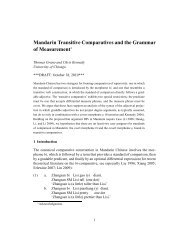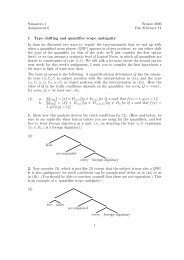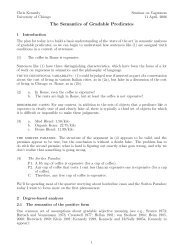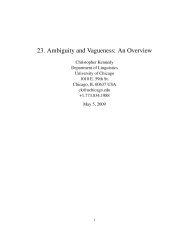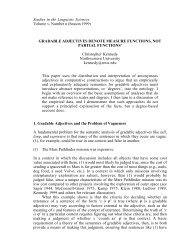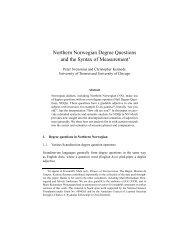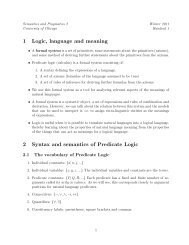On Multiple Wh-Fronting - University of Chicago
On Multiple Wh-Fronting - University of Chicago
On Multiple Wh-Fronting - University of Chicago
You also want an ePaper? Increase the reach of your titles
YUMPU automatically turns print PDFs into web optimized ePapers that Google loves.
368 ZÏ E L J K O B O SÏ K O V I Ćdeletion should take place in nontrivial chains. Thus, Chomsky (1995) argues that on the readingon which himself in (47) refers to Joe, the tail <strong>of</strong> the chain created by wh-movement <strong>of</strong> whichpicture <strong>of</strong> himself is deleted so that himself remains in Spec,CP, where it is c-commanded by Joebut not Jim. <strong>On</strong> the other hand, on the reading on which himself refers to Jim, himself is deletedin the head <strong>of</strong> the chain and remains in the structure in the tail <strong>of</strong> the chain, where it is c-commanded by and local to Jim. 2 7(47) Joe wonders [ C P [which picture <strong>of</strong> himself] [ IP Jim bought [which picture <strong>of</strong> himself]]]By contrast, it is <strong>of</strong>ten assumed that no choice about where deletion should take place in nontrivialchains is available in PF, the head always being the sole survivor, as in (48).(48) a. The student was arrested the student.b. *The student was arrested the student.c. *The student was arrested the student.d. *The student was arrested the student.However, a number <strong>of</strong> authors have argued that in PF there is also a choice concerning whichmember <strong>of</strong> a nontrivial chain survives deletion (see Bobaljik 1995, Brody 1995, Groat and O’Neil1996, Runner 1998, Hiramatsu 1997, Pesetsky 1997, 1998, Richards 1997, Roberts 1997, Franks1998, Nunes 1999, BosÏ ković 2001). Of particular interest here is the proposal made by Franks(1998), who argues that just as in LF there is a preference for deletion in the head position <strong>of</strong>nontrivial chains (at least with operator-variable chains), so also in PF deletion in the tail <strong>of</strong>nontrivial chains (i.e., deletion <strong>of</strong> lower copies) is just a preference. More precisely, a lowermember <strong>of</strong> a chain is pronounced instead <strong>of</strong> the head <strong>of</strong> the chain iff pronunciation in the headposition would lead to a PF violation, provided that the violation can be avoided by pronouncingthe lower member <strong>of</strong> the chain. 2 8 (By head <strong>of</strong> a chain I mean the highest member <strong>of</strong> a sequence<strong>of</strong> copies created by movement <strong>of</strong> the same element. I disregard the fact that in some cases twodifferent chains, an A-chain and an Ā-chain, are created by movement <strong>of</strong> the same element, asin <strong>Wh</strong>o i t i seems t i to t i know it?)Let us see what the proposal entails for (37). The ungrammaticality <strong>of</strong> (13b) and (16a) showsthat there is a syntactic requirement—namely, focus—that forces all wh-phrases in SC to movein overt syntax. This should also hold for the second sÏta in (37), which then also must underg<strong>of</strong>ocus movement. As a result, (37) has the following S-Structure representation. (I am ignoringthe lower copy <strong>of</strong> the first sÏta.)(49) [ F P sÏ ta sÏ ta i [uslovljava sÏ ta i ]]what what conditions what27 Chomsky’s analysis is slightly more complicated. He also argues that there is a preference for deletion in the head<strong>of</strong> operator-variable chains, motivated by *John wondered which picture <strong>of</strong> Tom i he i liked.28 Pesetsky’s (1997, 1998) system, which antecedes Franks’s, is very similar to it (see also Bobaljik 1995, Hiramatsu1997,BosÏ ković2001).However, Pesetsky does not explicitly claim that only PF considerations can license lower pronunciation,a position I wish to maintain.


